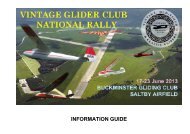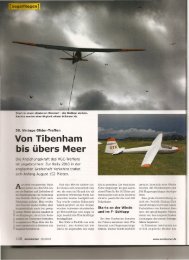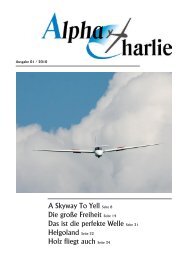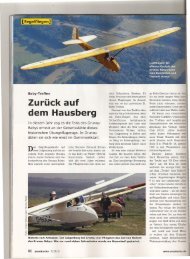Download - Vintage Glider Club
Download - Vintage Glider Club
Download - Vintage Glider Club
Create successful ePaper yourself
Turn your PDF publications into a flip-book with our unique Google optimized e-Paper software.
SNIPPETS<br />
searched in my technical library, I found<br />
it in my book “Bau von Gleit und<br />
Segelflugzeugen” by Hans Jacobs. (Construction<br />
of <strong>Glider</strong>s and Sailplanes). This<br />
book was printed in 1940. There it states<br />
that the glue was developed by Professor<br />
Klemm, so you are right in your presumption.<br />
The Kaurite glue was mixed<br />
with “KUNSTHARZ” (artificial resin) to<br />
give it elastic qualitiy”. Direct translation<br />
by CW. This is the known Kaurite<br />
glue. Klemmleim has been developed by<br />
Dr.Klemm. This consists of normal<br />
Kaurite with a meagre additive. This very<br />
much improves the elastic quality of the<br />
glue. This consists of the additive hardened<br />
artificial resin in powder form. It is<br />
called “Klemm Powder”. The preparation<br />
is exactly the same as that for normal<br />
Kaurite glue and the same RED cold<br />
hardener is used to set it”. CW thanks<br />
Ingvar very much for this information.<br />
CW<br />
CW also writes that some Kaurite glued<br />
skinned wings are still amazingly accurate<br />
(as are Casein glued wings), on<br />
Swedish and German war time built<br />
sailplanes. Whereas Aerolite glued<br />
Slingsby and Elliot wing skinned<br />
sailplanes sometimes reveal a “starved<br />
horse” effect. However, one can not complain<br />
about the accurate wing plywood<br />
surfaces of T.21b s etc. and the accuracy<br />
of CERTUS glued wing surfaces of old<br />
French sailplanes. CW asks whether<br />
CERTUS is an ancestor of AERODUX<br />
glue? That some Slingsby and Elliott<br />
plywood wing surfaces are good and others<br />
are not, makes CW wonder whether<br />
these firms also discovered an additive to<br />
make AEROLITE 300 glues more flexible?<br />
Frits Ruth writes that powdered bakelite<br />
was added to Kaurite glue in order to<br />
make it more flexible when set, so that<br />
there should be less distortion of plywood<br />
(better accuracy of profile) on<br />
wings etc.<br />
Progress<br />
in restoring the V-20<br />
by Neelco Osinga<br />
New glue<br />
Last week I visited the workshop of the<br />
Twentse Zweefvliegclub. Also Jan<br />
Forster was invited. He demonstrated a<br />
new way of covering the wings and fuselage,<br />
the Kautschuk glue method.<br />
Kautschuk glue is made by IRSA.<br />
Caoutchouc is the French word for non<br />
vulcanised rubber. The glue seems to be<br />
like the famous white cold glue for<br />
Above: hard at work on the V-20<br />
wood, e.g. Ceta Bever in the Netherlands.<br />
After drying, the glue becomes<br />
transparent and feels like rubber. It is a<br />
non poison stuff and nearly without<br />
smell.<br />
Jan Forster as a teacher<br />
Jan Forster is not only a good technician<br />
and member of our VGC committee but<br />
also a good teacher.<br />
He demonstrated the way to bring the<br />
glue like paint onto the torsion box of<br />
the wings and onto the ribs. The glue<br />
should not be dry when the fabric, in this<br />
case a new type of synthetic fabric of<br />
Diatex, is laid on the wing. On the torsion<br />
box, only a narrow track of glue has<br />
to be applied. To prevent drying, the glue<br />
is painted in sections of about maximum<br />
50 centimetres. After laying down, the<br />
glue has to be rubbed in the fabric. The<br />
fabric must be laid under some slight<br />
tension so that there are no folds. After<br />
completely drying the, the fabric can be<br />
brought on tension in the normal way;<br />
flat-iron and with dope and afterwards,<br />
eventually painted. Jan said that this<br />
method of covering the glider results in<br />
about half the weight of covering with<br />
old fashioned cotton fabric. After one day<br />
of hard work both wings had been covered.<br />
The V-20 gets its final look<br />
After covering the whole glider with the<br />
new fabric, inclusive of the fuselage, the<br />
glider will be painted in the original<br />
colours. The canopy is nearly ready<br />
according to the original photographs.<br />
The owner, Tonny Wensing, is collecting<br />
original pre-war instruments. I expect<br />
that Hans Bekker, the responsible technician,<br />
can finish the titanic works this<br />
year. But I know that both Tonny and<br />
Hans prefer safety and good quality,<br />
rather than hurry.<br />
The local television station in<br />
Enschede is making a documentary of the<br />
restoration works, a good promotion for<br />
gliding.<br />
Fantastic<br />
book for<br />
technicians<br />
For the members<br />
who want to learn<br />
the new method<br />
of covering the<br />
glider with the<br />
K a u t s c h u k<br />
method I warmly<br />
recommend<br />
the new book<br />
for technicians: "Houten<br />
zweefvliegtuigen & techniek", by Jan<br />
Forster, ISBN / EAN 978-90-9022122-<br />
9, issued by the VGC and the Vereniging<br />
Historische Zweefvliegtuigen (Dutch<br />
VGC). Price: €20.=. It is in the Dutch<br />
language. For those technicians who do<br />
not speak Dutch: an Englishman told me<br />
that he could understand about 90 % of<br />
the written text. The book has an appendix:<br />
a dictionary of Dutch, English and<br />
German technical words.<br />
I give an example of the quality of the<br />
book. Nobody could tell me the mechanism<br />
of shrinking of the fabric by doping,<br />
so that it will be tight, even not the<br />
well known technical books. The book<br />
of Jan gives a good explanation!<br />
VGC News No. 123 Spring 2008 27







